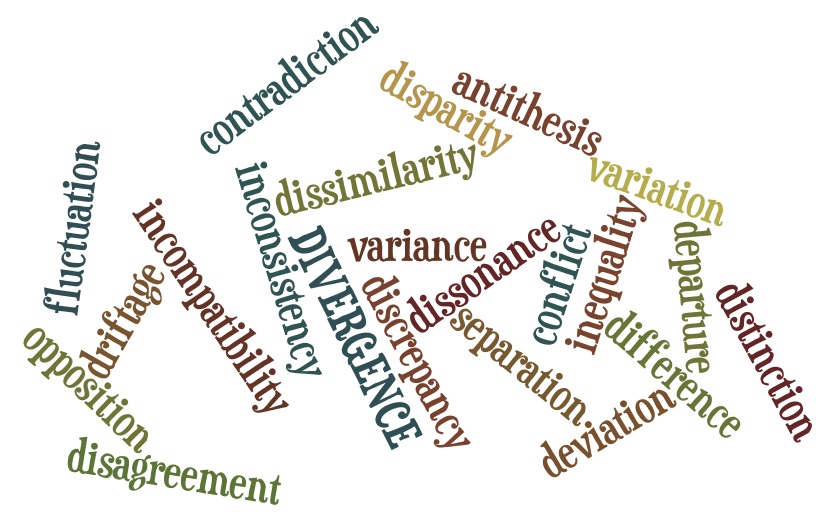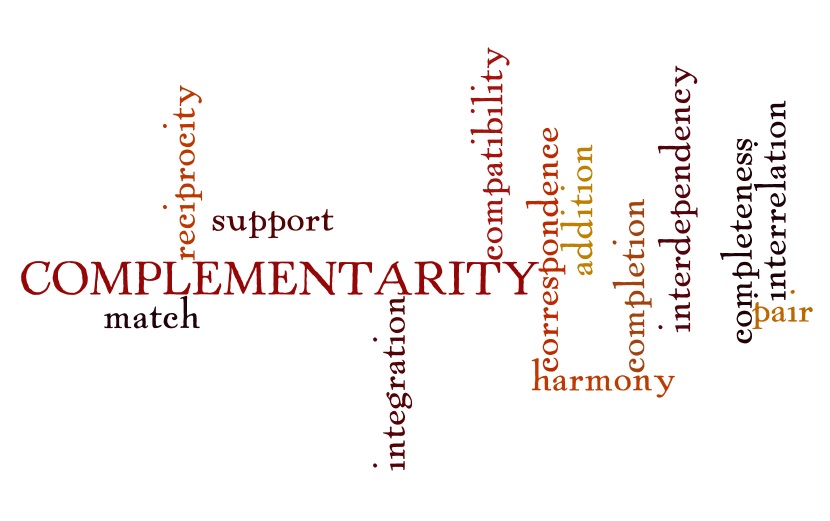A Coaching Power Tool Created by Monica Matei
(Life Coach, BELGIUM)
There is very little difference in people, but the little difference is attitude. W. Clement Stone
There is a tendency in any person to hold two or more contradictory beliefs, values, or actions at some point in time. The Power Tool “Divergence Vs. Complementarity” helps clients to diminish the mental stress or discomfort of continuously striving to reduce divergence. Ultimately, the power tool would help clients shift perspective and see “divergences” as natural “differences” that are complementing each other.
Definition of terms (as used in the purpose of the Power Tool):
- Divergence: dissonance, inconsistency, conflict, disagreement
- Complementarity: completeness, integration, harmony
The Two Sides of the Power Tool
 Divergence
Divergence
When one’s feelings, values or beliefs are perceived as divergent with the actions, individuals automatically embark in an unconscious process of reaching convergence among these. The psychological phenomenon that happens is that people have an automatic reaction to any type of inner divergence. Consequently, people will be seeking consistency between their beliefs, values and actions each time they diagnose themselves as “divergent” (dissonant) with own behaviors. They will naturally try to reduce the divergence and obtain convergence by any manner. In cognitive psychology this phenomenon is called “cognitive dissonance.”
What happens when individuals act in ways that are divergent with their prior intentions?
Example – Hypothetical situation:
Attitude:
I am going to save money and will avoid spending any coin on unnecessary things.
Behavior:
I am spending money for expensive cloths that I am not even wearing.
According to the Theory of Cognitive Dissonance, there are some ways people will try out to reduce divergence:
- Justify behavior by changing the divergence:
I’m allowed to send money on expensive clothes every once in a while.
- Justify behavior by adding a new agreement:
I’ll not buy food this week to balance the spending.
- Ignore/Deny any information that conflicts with existing beliefs:
I did not spend any cent on unnecessary things. I am considerate with my budget.
These represent automatic reactions (not responses) to an imaginary self diagnose where the sole purpose is to reduce divergence and reach convergence within self.
The “cognitive dissonance” phenomenon is very ingrained into our behaviors as humans, thus, it is very difficult to detach and distance ourselves from it. If people are not aware of this psychological mechanism, they will continue living form a disempowering perspective, where they condemn themselves as “divergent”. Consequently, they will end up consuming lots of energy, which will in return increase mental stress.
Just imagine a day where you do not think of yourself as “divergent”, and do not diagnose yourself either as “inconsistent,” or as “dissonant”, a day where you experience yourself as a beautiful and complementary mix of beliefs, attitudes and behaviors.
 Complementarity
Complementarity
Complementarity represents the new lenses to look at inner divergence. Complementarity does what divergence cannot, it looks at inconsistency or conflicting beliefs, values and actions as coherent and harmonious manifestations of one’s personality. Understanding inner divergence as “complementarity” all beliefs, feelings and actions will emphasize the complexity and beauty of our personality.
Example – Hypothetical situation:
Attitude:
I am going to save money and will avoid spending any coin on unnecessary things.
Behavior:
I am spending money for expensive cloths that I am not even wearing.
If we look at the situation from the disempowering perspective of divergence, as mentioned before, people will automatic embark in the mental process of trying to reduce divergence. But, if we look at this situation from the empowering perspective of “complementarity,” the behavior “I am spending money for expensive cloths that I am not even wearing” seems in harmony with one’s personality. “I am spending money because I have a reason to do that, because it makes sense, it serves me in some areas in my life, otherwise I would have not enrolled in such activity. Even if it is about reinforcing the need not to spend money, it will still make sense. Whatever the reason is, it shows me something about myself, it reveals to me new convictions or reinforces old beliefs.”
People usually do not pay too much attention to the reasons behind their actions, they rather quickly judge themselves and etiquette the actions as “wrong,” “not in conformity with” etc.
The “complementarity” perspective helps people stop diagnosing the inner incongruence (values, beliefs, actions) as there is no such thing. Everything has a meaning, even when it apparently looks the opposite. The invitation is to start wearing other glasses through which people look at their inner divergence. The new pair of glasses will make you see harmony, coherence, congruence in your thoughts and actions.
Self Application
When I set goals for myself and look at the actions that I perform every day to reach those initial intents, I am not judging the actions in relation to my intention. Instead I am looking at my actions in relation to my complex personality (complementarity perspective), so that I can see the sense in all I do. Moreover, I interpret my actions as a great source of information about myself, my hidden thoughts, beliefs and values.
Example – My Journey with ICA:
I enrolled in ICA and stated a goal for myself to build my website by end of my graduation. But I have never worked at it practically. Each time I intended to, I ended up by not working (there were various reasons that would stop or disturb me). The situation has been repeating all along my ICA journey.
“Divergence” Perspective
The lack of result (not having my website done) conducted to self blame and made me look at my behavior as divergent (dissonant), not consistent with my prior intention. So, my next unconscious reaction was to immediately reduce the inner divergence by justifying my behavior: such as “I needed a web designer to help me set the theme of the website, the colors and logo,” or “I would need pictures and testimonials that were not ready,” or “My coaching concept was not completely defined.” The mental stress to find the right justification for my behavior was overwhelming and energy consuming.
“Complementarity” Perspective
What if I start looking at my behavior from a more empowering perspective, where inner divergence does not exit, and accordingly I would not need to strive for consonance within my actions! Instead of stretching myself to achieve consistency in my thoughts and actions, I would rather spend the time in understanding what my behavior says about me, and about my underlying beliefs. Not having built my website, what does this tell about me?
What I discovered about myself was an ingrained value that says Take one step at a time.
This belief was indeed in harmony with my personality, as I am a person that likes to take small steps. Having set the goal to have my website done while completing all assessments for the ICA expresses actually my impatience to move things quickly than I was used to. In my case, the result of not having my website done reinforced my behavior of being patient, and do things when I am ready.
The complementary perspective created for me the chance to look at my behavior without judgment. At the end of the day, whatever actions I take they represent me and are complementary to my thoughts, values and beliefs.
Coaching Application
Each time we notice that our clients are struggling to find justifications for their actions, or they are in continuous denial of their intentions, or avoid information that conflicts with their beliefs or actions, that is a clear sign of a cognitive dissonance (divergence) phenomenon. We can support our clients in getting more awareness around what is actually happening in their head, and how this mental process of cognitive dissonance limits themselves to live in a disempowering perspective.
What a coach can practically do:
What is the color, shape, smell of that freedom?
Journaling
Ask the client to keep a journal of their actions (what they consider important) or to keep note of their behaviors for a short period of time. Then, ask them to identify what might be the reinforcing beliefs (or hidden beliefs), commitments, thoughts or values behind those. In the end invite them to reflect on the “complementary” and “harmonious” nature of their personality.
Non-resistance approach
Focus the client towards what they want and how to get there, moving from how was it possible for me to behave like that? to what can I learn from my behavior to help me move forward?
Invite them to find a recent example of a situation where they behaved in a certain way and to share the impressions about what happened. Ask them what they think it comes first, the conclusion or the facts that support it?
Usually people are prone to take a conclusion first and afterwards start collecting evidence to backup this conclusion (cognitive dissonance). That’s why if they change the conclusion, they will see that the information they have being collecting will change.
Questions to help shift from “divergence” to “complementarity” perspective:
Reflections:
- What is your perspective (lenses) through which you look at your actions: “divergence” or “complementarity”?
- How have you supported yourself to change towards a more empowering perspective?
- How can you support your client discern the thoughts and actions that might derive from “cognitive dissonance?”
- What are some powerful questions you can ask your client if you notice a high self criticism towards own actions?
- How can you uncover some of the triggers the client might have towards self diagnosing as “divergent” or “inconsistent?”
- What role does “inner harmony” plays in coaching, both for you as a coach and for your client?
- How the knowledge of this power tool might help your clients to positively change their lives?
References:
Festinger, L. A Theory of Cognitive Dissonance. California: Stanford University Press, 1957
Gawronski, B., & Strack, F. Cognitive consistency: A fundamental principle in social cognition.
New York: Guilford Press, 2012
Tavris, C.; Aronson, E. Mistakes were made (but not by me): Why we justify foolish beliefs, bad decisions, and hurtful acts. Orlando, FL: Harcourt, 2007
Saul McLeod. “Cognitive Dissonance”. Retrieved 3 December 2013, from:
http://www.simplypsychology.org/cognitive-dissonance.html
Harmon-Jones, E., Brehm, J.W., Greenberg, J., Simon, L., & Nelson, D.E. Evidence that the production of aversive consequences is not necessary to create cognitive dissonance, 1996, from:
http://www.socialemotiveneuroscience.org/pubs/hj_etal96.pdf
Brain Quote, from:
http://www.brainyquote.com/quotes/quotes/w/wclements193770.html